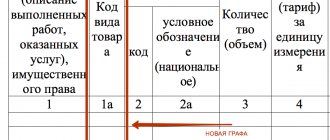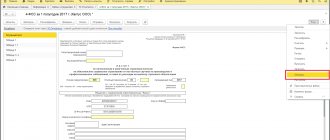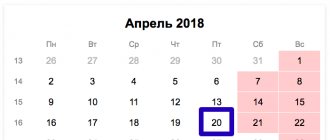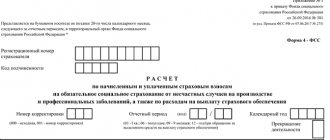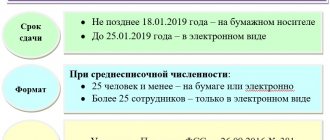The invoice from January 1, 2021 continues to be filled out in accordance with the requirements of Government Decree dated December 26, 2011 No. 1137 as amended. from 02/01/2018. Without a correctly executed invoice, it is impossible to justify the right to reflect in accounting the fact of accepting VAT amounts for deduction. The sample invoice has not changed since 2019, but when filling out the document you will need to indicate the updated tax rate due to the increase in the tax rate to 20% (the rate before 01/01/2019 was 18%). The deadline for issuing invoices in 2021 remained the same - 5 days (clause 3 of Article 168 of the Tax Code of the Russian Federation), counted from the moment:
- shipment of goods or acceptance of work performed;
- transfer of property rights;
- receiving payment (as an advance on future deliveries).
VAT rate 18% in the contract
If your agreement specifies a VAT rate of 18%, then there is no need to change it.
From 01/01/2019 you ship goods/provide services at a rate of 20%, in accordance with clause 4 of Art. 168 Tax Code of the Russian Federation. If you are still confused by this situation, then draw up an additional agreement to the contract, which will spell out all the “inconvenient” points.
This situation can cause confusion because nowhere in the Tax Code of the Russian Federation does it say what should be spelled out in the contract and how to act if the situation has changed.
Judicial practice shows that the buyer can sue the supplier and win the case if the contract specifies one contract amount, and you suddenly unilaterally indicate a different price in the invoice and demand payment of exactly that amount.
The situation in this case is slippery, because the law obliged us to raise VAT. The Letter of the Ministry of Finance of the Russian Federation dated August 28, 2018 No. 24-03-07/61247 states that, according to Part 2 of Art. 34 of the Law on the Contract System, the contract price is not subject to change for the entire duration of its validity. But in the same letter, a few paragraphs below, Government Resolution No. 1186 of December 19, 2013 is quoted, which states that the essential terms of the contract can be revised if changes occur due to circumstances beyond the control of the parties.
So if you are in a situation where you could lose a large amount due to a rate change, please refer to this ruling.
Structure and filling rules
A zero invoice consists of three main blocks: header, main part, signatures. In the upper part it is necessary to write down the names of the parties and their details, the second block directly concerns the goods or services, their characteristics, the third block consists of affixing signatures by authorized persons. Filling out the form is usually not difficult if you know the matter. Let's dwell on the structure and correct filling of the invoice.
- First, enter the account number and the date of its issue. In this case, the serial number must be observed.
- Next line for corrections. If they are absent, a dash is placed.
- Salesman. Involves entering accurate data in accordance with the constituent documents of the organization.
- Seller's address. Accurate data is entered in the same way.
- Entering TIN/KPP.
- Shipper. If it matches the seller, you can enter the same one.
- Consignee, indicate the exact name and address.
- A payment and settlement order requires entering the invoice data.
- Next, there are similar lines about the buyer, they must be filled out in accordance with the documents.
- The string is relative to the currency. Indicate in which currency the payment is made.
We invite you to read: Should a tax deduction be provided for the child of an employee on maternity leave?
Main part
- No. 1 product name. The goods must match the data on the invoice receipt.
- No. 1a product type code. This line is intended only for organizations supplying goods to the EAEU countries. In the absence of this activity, you need to put a dash.
- Two lines together. No. 2, write down the code for the classifier. 2a symbol, if absent, put a dash.
- No. 3 quantity, volume. Enter the data according to the invoice receipt.
- No. 4 price per unit of measurement. Enter the data according to the invoice receipt.
- No. 5 cost of goods. Specify the price for the total quantity excluding VAT.
- No. 6 excise tax amount. If not available, indicate without excise tax.
- No. 7 VAT rate. Be sure to indicate “excluding VAT” for all products.
- No. 8 tax amount to the buyer. Be sure to indicate “excluding VAT” for all products.
- No. 9 the cost of goods and services along with tax payments. Indicate the total amount of goods on the invoice.
- The next three tables are for foreign goods. It is necessary to provide information about the country of origin and the customs declaration number.
IMPORTANT: ensure that all invoice lines are filled out correctly. Otherwise, the tax inspectorate will have questions.
Signatures
The document must be legalized with the signatures of authorized persons. For the organization, the signatures of the chief accountant and the manager are required. Instead of the head of a legal entity, a zero invoice can be signed by an authorized representative.
An individual entrepreneur signs a document without the participation of an accountant. He can also authorize another person to sign the document. In addition to the signature, surname and initials, the entrepreneur must write down the details of his certificate.
2% surcharge to VAT
You have a good relationship with the buyer, and after receiving the advance payment, you agreed with him that he will pay another 2%, and you will not lose anything on the sale.
There are two options for further developments: the additional payment was made before the rate increase and after. Let's look at both.
- Payment until 01/01/2019. Since in 2021 the rate is 18%, this 2% is considered as an additional payment - you decided that you want to pay more than the cost of the product/service, and, accordingly, tax must be charged on it. After receiving the 2% prepayment, you issue an adjustment invoice, which reflects the change in cost, but, accordingly, at the same rate of 18/118 (Table 1).
Table 1. Change in cost including VAT when paid before January 1, 2021
| Name of goods (description of work performed, services provided), property rights | Indicators in connection with changes in the cost of goods shipped (work performed, services provided) | Tax rate | Tax amount | Cost of goods (works, services), property rights with tax - total |
| Furniture delivery | A (before change) | 18/118 | 18 | 118 |
| B (after change) | 18/118 | 18,3 | 120 | |
| B (increase) | X | 0,3 | 2 |
- Payment after 01/01/2019. If the buyer paid the difference of 2% already in 2021, then this is not an overpayment, but is considered part of the prepayment. In this case, the seller must issue an adjustment invoice indicating the new VAT rate of 20/120 (Table 2).?
Table 2. Change in cost including VAT when paying after January 1, 2021
| Name of goods (description of work performed, services provided), property rights | Indicators in connection with changes in the cost of goods shipped (work performed, services provided) | Tax rate | Tax amount | Cost of goods (works, services), property rights with tax - total |
| Shoe supply | A (before change) | 18/118 | 18 | 118 |
| 118 | B (after change) | 20/120 | 20 | 120 |
| B (increase) | X | 2 | 2 |
- Prepayment from the organization using the simplified tax system. If this payment was made by a person who is not a VAT payer, then a single adjustment document is issued, which will contain combined data on such transactions. What kind of document this is and how it will be implemented in the accounting databases has not yet been clarified.
About line 070 of the VAT return: from the Letter it follows that the difference indicated in the adjustment invoice should be reflected in column 5 of line 070 of the VAT return and is included in the tax calculation, but in column 3 of the same line “0” is indicated.
The moment is somewhat unclear. Line 070, which reflects advances received, is filled in automatically, column 5 indicates the amount of tax, and column 3 indicates the basis for its calculation. It turns out that we do not have a basis for calculation, but the tax is still calculated. We are waiting for clarification from the Federal Tax Service.
One last thing about 2%. You have received an advance payment made in the total amount in 2021, and immediately calculated taking into account the 20% rate. Since the tax rate is 18% in 2021, the tax is calculated at the rate of 18/118 and no adjustment invoice is issued.
How to exercise the right to release?
If a taxpayer, having analyzed his activities over the past months, finds compliance with the VAT exemption criteria prescribed in Article 145, then the following actions should be taken:
- Fill out a standard form for notification of your right (its form is approved by Federal Law No. 58-FZ of June 29, 2004);
- Send a completed notification to the tax office - before the twentieth day of the month from which the company was able to exercise this right, the twentieth day is included here;
- Prepare extracts from the balance sheet (for legal entities), books of income and expenses (for individual entrepreneurs), books of sales and attach them to the notification when submitting documentation to the Federal Tax Service. The forms of extracts of these documents are not regulated by legislators.
You can submit the indicated documents by visiting the tax office in person. You can also transfer the documentation through Russian Post by issuing a registered letter with an inventory and notification of delivery.
If all the listed actions and conditions are met by the taxpayer, then he can enjoy the right to tax exemption for 1 year (or until the conditions are violated). Throughout this period, the obligation to issue VAT-free invoices to customers remains.
If at the end of the year the company can still take advantage of the VAT exemption, then it must again inform the tax authority of its right - no later than the twentieth day of the next month. The list of documents is similar to the primary notification.
Change in the cost of goods/services after 01/01/2019
Nowadays, adjustments to invoices/acts are common.
What to do if such an adjustment becomes necessary to make after the VAT rate has changed? The Letter states that, as expected, it states the rate and amount before and after the changes made. But what’s interesting is that in the last paragraph of clause 1.2 of the Letter it is directly stated that, regardless of whether the change led to an increase or decrease in the original amount, in column 7 “Tax rate” the same rate is indicated as in the initial invoice.
When is an advance invoice issued?
If the Tax Service, during an audit, establishes violations when issuing invoices for advance payments, then you can pay a fine of 10 to 40 thousand rubles. Also, the company will have an obligation to pay VAT on advances for which invoices have not been issued. But it will be impossible to use the right to a refund of this VAT, since such compensation was not indicated in the VAT return.
- The invoice must include VAT as a separate line.
- If the prepayment amount cannot be divided into different goods, then in the advance invoice it is allowed to indicate a general name and the estimated VAT rate of 18/118.
For advance payments, the basis for calculating VAT is the amount of the advance payment received. If an advance payment is received for goods that are subject to different VAT rates, then separate invoices must be prepared.
VAT on returns
Letter No. SD-4-3/ [email protected] dated October 23, 2018 states a completely new interpretation of returns, namely, now these are not returns, but adjustments to the implementation.
The legislator refers to clause 13 of Art. 171 and paragraph 10 of Art. 172 of the Tax Code of the Russian Federation, which talks about adjusting sales downward. Previously, there was some confusion with returns, because the buyer could accept the goods, but could not register it, and the return could also be a reverse sale - when a full-fledged product was returned, there could be a real return of the defective product. Now all this will be reflected in the income adjustment.
Regarding the changed rate: if the sale was before 01/01/2019, then the adjustment invoice indicates a rate of 18%. If an adjustment is issued to an organization on the simplified tax system, then one consolidated document is created, which reflects data on all such operations.
Materials from the newspaper “Progressive Accountant”
Features of the document
An invoice performs two main tasks: to record the fact of a transaction and to record the payment of VAT. A zero invoice is intended for the category of entrepreneurs and organizations exempt from VAT; it only confirms the transaction. This document specifies in detail the list of goods, services, their quantity and price, the names of the parties and their details.
The provisions regarding the structure of the invoice and the procedure for filling it out are defined in the Decree of the Government of the Russian Federation No. 1137 dated December 26, 2011.
Rules for issuing invoices in electronic form from 2021 (draft)
The format of the electronic invoice was approved by order of the Federal Tax Service dated March 24, 2021 No. ММВ-7-15/
The Tax Code of the Russian Federation does not say how the parties must show their consent to the exchange of electronic documents. Therefore, you can, for example, draw up an additional agreement. However, the existence of an agreement does not prevent the seller from presenting the document on paper. If you have a paper form, there is no need to duplicate it in subsequent electronic form (letter of the Federal Tax Service of Russia dated June 17, 2013 No. ED-4-3/10769).
You can send electronic documents only through electronic document management operators (clause 1.3 of the Procedure, approved by Order of the Ministry of Finance of Russia dated November 10, 2015 No. 174 n).
When is an advance invoice issued?
If the Tax Service, during an audit, establishes violations when issuing invoices for advance payments, then you can pay a fine of 10 to 40 thousand rubles. Also, the company will have an obligation to pay VAT on advances for which invoices have not been issued. But it will be impossible to use the right to a refund of this VAT, since such compensation was not indicated in the VAT return.
- The invoice must include VAT as a separate line.
- For advance payments, the basis for calculating VAT is the amount of the advance payment received. If an advance payment is received for goods that are subject to different VAT rates, then separate invoices must be prepared.
- If the prepayment amount cannot be divided into different goods, then in the advance invoice it is allowed to indicate a general name and the estimated VAT rate of 18/118.
